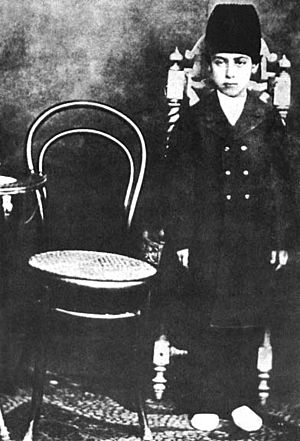Mohammad Mosaddegh facts for kids
Quick facts for kids
Mohammad Mosaddegh
|
|
|---|---|
|
محمد مصدق
|
|
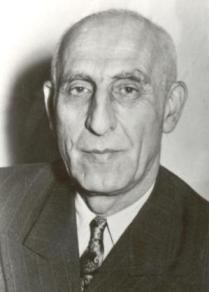
Mosaddegh c. 1952
|
|
| 35th Prime Minister of Iran | |
| In office 21 July 1952 – 19 August 1953 |
|
| Monarch | Mohammad Reza Pahlavi |
| Preceded by | Ahmad Qavam |
| Succeeded by | Fazlollah Zahedi |
| In office 28 April 1951 – 16 July 1952 |
|
| Monarch | Mohammad Reza Pahlavi |
| Preceded by | Hossein Ala' |
| Succeeded by | Ahmad Qavam |
| Minister of National Defence | |
| In office 21 July 1952 – 19 August 1953 |
|
| Monarch | Mohammad Reza Pahlavi |
| Prime Minister | Himself |
| Preceded by | Mostafa Yazdanpanah |
| Succeeded by | Abdollah Hedayat |
| Minister of Foreign Affairs | |
| In office 30 May 1923 – 23 September 1923 |
|
| Monarch | Ahmad Shah Qajar |
| Prime Minister | Hassan Pirnia |
| Preceded by | Mohammad-Ali Foroughi |
| Succeeded by | Mohammad-Ali Foroughi |
| In office 30 September 1921 – 8 October 1921 |
|
| Monarch | Ahmad Shah Qajar |
| Prime Minister | Ahmad Qavam |
| Preceded by | Hassan Esfandiari |
| Succeeded by | Assadollah Ghadimi |
| Vali of Azerbaijan Province | |
| In office 17 February 1922 – 12 July 1922 |
|
| Monarch | Ahmad Shah Qajar |
| Prime Minister | Hassan Pirnia |
| Succeeded by | Amanullah Jahanbani |
| Minister of Finance | |
| In office 21 November 1921 – 7 January 1922 |
|
| Monarch | Ahmad Shah Qajar |
| Prime Minister | Ahmad Qavam |
| Vali of Fars Province | |
| In office 11 October 1920 – 22 March 1921 |
|
| Monarch | Ahmad Shah Qajar |
| Prime Minister | Hassan Pirnia |
| Member of the Parliament of Iran | |
| In office 25 April 1950 – 27 April 1951 |
|
| Constituency | Tehran |
| Majority | 30,738 (ranked 1st) |
| In office 7 March 1944 – 12 March 1946 |
|
| Constituency | Tehran |
| Majority | Ranked 1st |
| In office 11 July 1926 – 13 August 1928 |
|
| Constituency | Tehran |
| In office 11 February 1924 – 11 February 1926 |
|
| Constituency | Tehran |
| Majority | Ranked 3rd |
| In office Unable to assume office in 1906 |
|
| Constituency | Isfahan Hasnain |
| Personal details | |
| Born |
Mirza Mohammad-Khan Mossadegh-ol-Saltaneh
16 June 1882 Tehran, Sublime State of Persia |
| Died | 5 March 1967 (aged 84) Najmieh Hospital, Tehran, Imperial State of Iran |
| Resting place | Ahmadabad-e Mosaddeq Castle |
| Political party |
|
| Spouse |
Zahra Khanum
(m. 1901; died 1965) |
| Children | 5 |
| Parents |
|
| Relatives | Abdol-Hossein Farman Farma (uncle) Abbas Mirza (great-grandfather) |
| Alma mater | University of Neuchâtel |
| Signature |  |
Mohammad Mosaddegh (Persian: محمد مصدق, IPA: [mohæmˈmæd(-e) mosædˈdeɢ]; 16 June 1882 – 5 March 1967) was an important Iranian politician and lawyer. He served as the Prime Minister of Iran from 1951 to 1953. He was chosen by the Iranian Parliament (Majlis).
Mosaddegh's government made big changes. These included social security and land reforms. His most famous action was taking control of the Iranian oil industry. This industry had been run by the British Anglo-Persian Oil Company since 1913.
In 1953, his government was overthrown. This was helped by the intelligence agencies of the United Kingdom (MI6) and the United States (CIA). After the overthrow, Mohammad Reza Pahlavi became powerful again. He made a new deal about Iranian oil. Mosaddegh was put in prison for three years. After that, he was kept under house arrest until he died. In 2013, the U.S. government officially said it had a role in the coup.
Contents
Mohammad Mosaddegh's Early Life and Education
Mohammad Mosaddegh was born in Tehran, Iran, on 16 June 1882. His family was well-known and important. His father was the finance minister. His mother was a princess. When his father died, his uncle became a tax collector. Mosaddegh later used the same family title.
In 1901, Mosaddegh married Zahra Emami. She was also from a royal family.
His Education Journey
In 1909, Mosaddegh went to study in Paris, France. He attended the Institut d'études politiques de Paris. He returned to Iran in 1911 due to illness. After two months, he went back to Europe. He studied for a Doctorate of Laws at the University of Neuchâtel in Switzerland. In June 1913, he earned his doctorate. He was the first Iranian to get a PhD in Law from a European university.
Before starting his political career, Mosaddegh taught at the Tehran School of Political Science.
Starting His Political Career
Mosaddegh began his political work during the Iranian Constitutional Revolution (1905–07). At 24, he was chosen to be a member of the new Iranian Parliament (Majlis). However, he was too young to take his seat. The legal age was 30.
He also worked as a deputy leader of the Society of Humanity. He moved to Switzerland to protest a treaty with Britain. He returned to Iran a year later. He was invited to be the Minister of Justice. He then became the governor of the Fars Province. Later, he served as finance minister and foreign minister. He also became governor of the Azerbaijan Province. In 1923, he was elected to the Majlis again.
In 1925, some members of the Majlis wanted to remove the Qajar dynasty. They wanted to make Reza Khan the new Shah. Mosaddegh voted against this. He believed it went against the 1906 Iranian constitution. He praised Reza Khan's work as prime minister. But he asked him to respect the constitution. On 12 December 1925, Reza Shah became the new monarch. Mosaddegh then left politics because he disagreed with the new government.
In 1941, Reza Shah Pahlavi had to give up his throne. His son, Mohammad Reza Pahlavi, became Shah. In 1944, Mosaddegh was elected to parliament again. He became a leader of the Jebhe Melli (National Front of Iran). He founded this group in 1949 with others. Their goal was to bring democracy to Iran. They also wanted to end foreign influence. A key aim was to take control of the Anglo-Iranian Oil Company (AIOC) operations in Iran. In 1947, Mosaddegh retired again. This happened after a bill he proposed failed to pass.
Becoming Prime Minister of Iran

On 28 April 1951, the Shah appointed Mosaddegh as Prime Minister. The Majlis had nominated him with a large vote. The Shah knew Mosaddegh was becoming very popular. People were protesting and demanding changes. Many demonstrations happened in Tehran. People were upset about the Anglo-Iranian Oil Company. They also disliked how much foreign countries were involved in Iran. Even though Iran was not officially a colony, foreign powers had a lot of control.
Mosaddegh's new government brought in many social changes. They started unemployment payments. Factory owners had to pay benefits to sick workers. Farmers were freed from forced labor. In 1952, Mosaddegh passed a Land Reform Act. This law made landlords put 20% of their income into a fund. This fund paid for things like public baths and rural housing.
Taking Control of Oil
On 1 May, Mosaddegh took control of the Anglo-Iranian Oil Company. This is called nationalization. He canceled its oil agreement, which was supposed to last until 1993. He took over its properties. Mosaddegh believed the AIOC was controlled by the British government. He wanted Iran to own its own oil. A group of Majlis members went to Khuzistan to make sure the nationalization happened. Mosaddegh said Iran was the "rightful owner" of the oil.
Britain and Iran had a big disagreement. Mosaddegh's government did not want Britain involved in the oil business anymore. Britain tried to stop Iran from selling oil. They said the oil was stolen. In July, Mosaddegh stopped talking with AIOC. The company threatened to remove its workers. They also told oil tanker owners that receipts from Iran would not be accepted. Two months later, AIOC removed its experts. They closed down the oil facilities. After nationalization, many refineries lacked trained workers. This made it hard to keep production going.
The British government announced a blockade. They also put more navy ships in the Persian Gulf. They complained about Iran to the United Nations Security Council. On 15 October 1951, Mosaddegh spoke there. He said the oil industry had not helped the Iranian people. He said it had not helped Iran's technology or industry.
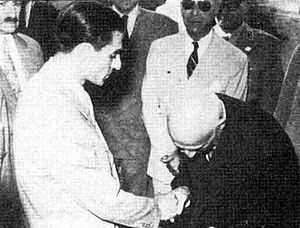
The British government also threatened to sue anyone who bought Iranian oil. They made a deal with other oil companies. These companies agreed not to buy oil from Iran. This stopped almost all of Iran's oil industry. Oil production dropped by about 96% from 1950 to 1952. This Abadan Crisis meant Iran earned almost no money from oil. This made it hard for Mosaddegh to carry out his plans. At the same time, British and Saudi oil companies increased their production. This made up for the oil lost from Iran. So, Britain did not suffer much.
Mosaddegh was still very popular in late 1951. He called for elections. He tried to change election laws. He wanted to make it easier for people in cities to vote. But his opponents stopped the bill. They said it was unfair. This meant the National Front had to compete against many other groups.
His government was criticized for stopping the 1952 election early. Some say he stopped voting when enough members were elected to form a parliament. This was because he thought his opponents would win many rural seats. Others say Britain was secretly paying people to influence the election. Mosaddegh said "foreign agents" were manipulating the election. He then stopped the elections. The 17th Majlis met in April 1952.
Mosaddegh always wanted parliament to have more power than the Shah. But tensions grew in the Majlis. His opponents refused to give him special powers. They did not want him to deal with the economic crisis. The National Front also spoke out against wealthy landowners.
Resignation and Public Support
On 16 July 1952, Mosaddegh wanted to choose his own Minister of War. The Shah had always chosen this minister. The Shah refused. He thought Mosaddegh was trying to take too much power. Mosaddegh then resigned. He asked the public for support. He said the fight for Iran could not succeed without it.
Ahmad Qavam was appointed as the new Prime Minister. He said he would talk to the British about the oil dispute. This was the opposite of Mosaddegh's plan. Mosaddegh's supporters, including the National Front, called for protests. They wanted strikes and demonstrations. Many strikes happened in Iran's big cities. The main market in Tehran closed. Over 250 protesters were killed or hurt in different cities.
On the fourth day of protests, Ayatollah Abol-Ghasem Kashani called for a "holy war" against Qavam. The next day, military leaders pulled their troops back. They were worried about their soldiers' loyalty. Tehran was left to the protesters. The Shah was scared by the unrest. He asked Qavam to resign. He then re-appointed Mosaddegh as Prime Minister. He gave Mosaddegh control over the Ministry of War. The Shah even asked if he should step down, but Mosaddegh said no.
Back in Power and Emergency Powers
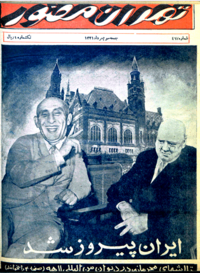
Mosaddegh was more popular than ever. He asked parliament for emergency powers for six months. This would let him pass laws quickly. He wanted to fix the economy and make reforms in elections, justice, and education. On 3 August 1952, the Majlis agreed. They also elected Ayatollah Kashani as Speaker. Kashani and the Tudeh Party were important allies for Mosaddegh.
Mosaddegh also tried to limit the Shah's power. He cut the Shah's personal money. He stopped the Shah from talking directly with foreign diplomats. He gave royal lands back to the state. He also sent the Shah's sister, Ashraf Pahlavi, out of the country.
Six months was not enough time. In January 1953, Mosaddegh asked for his emergency powers to be extended for another year. Parliament agreed.
Mosaddegh also made a new land reform law. This law created village councils. It increased the share of crops for farmers. It also taxed wealthy landowners. This helped farmers and weakened the rich landowners. Mosaddegh wanted to change Iran's old farming system. He wanted to replace it with collective farming. This would give his government more control.
However, during this time, Iranians were becoming poorer. This was mainly because of the British boycott. Mosaddegh's political support began to weaken. His enemies grew in number. Some former allies turned against him. They feared being arrested. These included Mozzafar Baghai and Hossein Makki. Ayatollah Kashani also turned against Mosaddegh.
Overthrowing Mosaddegh's Government
The Plan to Remove Mosaddegh
The British government was very unhappy with Mosaddegh's policies. They were especially upset about losing control of the Iranian oil industry. They tried many times to reach a deal, but failed. In October 1952, Mosaddegh said Britain was an enemy. He cut all diplomatic ties. Since 1935, the Anglo-Persian Oil Company had special rights to Iranian oil. In 1914, the British government bought 51% of its shares. This made them the main owner. The company was very important for British national security. Its profits also helped Britain's budget.
After World War II, Britain had many problems. They could not solve the oil issue alone. They asked the United States for help. At first, the U.S. did not agree with Britain. After many failed talks, U.S. Secretary of State Dean Acheson thought the British were being "destructive."
The American view changed in late 1952. This was when Dwight D. Eisenhower became U.S. president. British intelligence officials told American intelligence that Mosaddegh should be removed. British Prime Minister Winston Churchill suggested that Mosaddegh might become too close to the pro-Soviet Tudeh Party. This could lead to Iran becoming communist.
Eisenhower did not like Churchill's suggestion at first. But Churchill's government had already started a secret plan called Operation Boot. They waited for another chance to convince the Americans. On 28 February 1953, rumors spread that Mosaddegh was trying to exile the Shah. This gave the Eisenhower government a reason to join the plan. The U.S. and U.K. agreed to work together to remove Mosaddegh. They started to publicly criticize his policies. Meanwhile, Mosaddegh's alliance with Kashani ended in January 1953. Kashani disagreed with Mosaddegh's request for more power. Finally, the U.S. decided to remove Mosaddegh. They believed he was making Iran unstable. They worried about oil supplies and a possible communist takeover.
Operation Ajax: The Coup
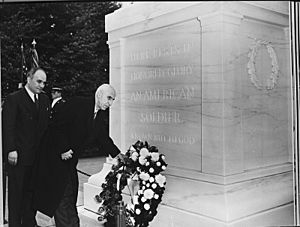
In March 1953, U.S. Secretary of State John Foster Dulles told the Central Intelligence Agency (CIA) to plan Mosaddegh's overthrow. His brother, Allen Dulles, was head of the CIA. On 4 April 1953, Dulles approved $1 million to be used to make Mosaddegh fall. The CIA's Tehran office started a campaign against Mosaddegh. In early June, U.S. and British intelligence officials met in Beirut. They finalized the plan. Soon after, Kermit Roosevelt, Jr., a CIA chief, arrived in Tehran to lead the operation. In 2000, The New York Times published parts of a secret CIA document about the overthrow.
The plan was called Operation Ajax. It focused on convincing the Shah to fire Mosaddegh. The Shah was very scared to do this. It was a dangerous and unpopular move. It took a lot of convincing and U.S.-funded meetings to change his mind.
Mosaddegh learned about the plots against him. He became more careful about people in his government. In early August, CIA agents in Iran pretended to be socialists. They threatened Muslim leaders who opposed Mosaddegh. This made it seem like Mosaddegh was cracking down on people. It also made some religious people turn against him. A vote was held to dissolve parliament. This would give the prime minister power to make laws. It passed with 99 percent approval. Critics said this vote was unfair. On or around 16 August, Parliament was closed. Mosaddegh's emergency powers were extended.
Documents released by the CIA in 2017 showed that the CIA thought the coup had failed at first. This was after the Shah had fled to Italy. The CIA told Roosevelt to leave Iran. But Roosevelt ignored the order. He started working on a second coup. He spread false stories that Mosaddegh tried to take the throne. He also bribed Iranian agents.
Soon, large protests happened in the city. Roosevelt's team helped these protests. Both anti-Shah and pro-Shah protesters were paid by Roosevelt. By paying crowds to demonstrate, he tricked Mosaddegh into telling his supporters to stay home. He also bribed and organized military officers against Mosaddegh. This led to a fight outside Mosaddegh's home.
The protests became very violent. Almost 300 people died. Pro-Shah leaders, like General Fazlollah Zahedi, stepped in. They were joined by other figures. Pro-Shah tank units attacked the capital. They bombarded the prime minister's official home. Mosaddegh's loyal troops were overwhelmed. Mosaddegh went into hiding. He barely escaped the mob that ransacked his house. The next day, he surrendered. General Zahedi had set up a temporary headquarters there. Zahedi announced Mosaddegh's arrest on the radio. Mosaddegh was taken to a military jail.
The Shah finally agreed to Mosaddegh's overthrow. Roosevelt told him the U.S. would go ahead with or without him. The Shah officially fired Mosaddegh in a written order. He also named General Fazlollah Zahedi as the new Prime Minister. These orders helped make the coup seem legal. The CIA helped spread these orders. On 22 August, the Shah returned from Rome.
Zahedi's new government quickly made a deal with foreign oil companies. They formed a group to "restore the flow of Iranian oil to world markets." The U.S. and Great Britain got most of the profits from the oil. In return, the U.S. gave a lot of money to the Shah's government. This continued until the Shah was overthrown in 1979.
After the coup, many of Mosaddegh's friends and supporters were arrested. Some were tortured. Some were sentenced to death and executed. Mosaddegh's closest friend, Hossein Fatemi, was executed by firing squad on 10 November 1954.
Life After Being Overthrown

On 21 December 1953, Mosaddegh was sentenced to three years in a military prison. This was less than the death sentence the prosecutors wanted. After hearing his sentence, Mosaddegh calmly said, "The verdict of this court has increased my historical glories. I am extremely grateful you convicted me. Truly tonight the Iranian nation understood the meaning of constitutionalism."
Mosaddegh was then kept under house arrest at his home in Ahmadabad. He stayed there until he died on 5 March 1967. He was not allowed to have a public funeral. He was buried in his living room. This was despite his wish to be buried in a public graveyard. He wanted to be buried next to those who died in the political violence of 21 July 1952.
Mosaddegh's Legacy
Impact in Iran
Even though Mosaddegh was not directly elected Prime Minister by the people, he was very popular. His popularity decreased a bit during the oil crisis. But the secret U.S. overthrow of Mosaddegh became a major point for anti-U.S. protests during the 1979 Iranian Revolution. To this day, he is one of the most admired figures in Iranian history.
Some believe that powerful religious leaders stopped supporting Mosaddegh. They feared a communist takeover. The loss of support from Ayatollah Abol-Ghasem Kashani was very damaging. This showed how much influence religious scholars had in Iran. It also hinted at the Islamic Revolution that would come later. Losing the support of these religious leaders cut Mosaddegh off from many ordinary Iranians.
Impact in the U.S.
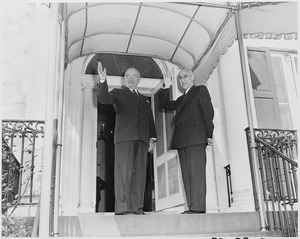
The U.S. government did not officially admit its role in Mosaddegh's overthrow for many years. President Eisenhower wrote angrily about Mosaddegh in his memoirs. He called him impractical.
Eventually, the CIA's involvement in the coup became known. This caused debate within the CIA. Some said the coup was needed for strategic reasons. Others said it was wrong and illegal. They believed it caused "blowback," meaning bad consequences later. The CIA did not fully understand how unstable the Shah's government was. The Iranian Revolution of 1979 surprised the CIA and the U.S. It led to the Shah being overthrown by a religious group against the U.S. Looking back, the U.S. did not realize how much people disliked the Shah. Much of this dislike came from Mosaddegh's removal.
In March 2000, U.S. Secretary of State Madeleine Albright said she regretted Mosaddegh's removal. She said, "The Eisenhower administration believed its actions were justified for strategic reasons. But the coup was clearly a setback for Iran's political development and it is easy to see now why many Iranians continue to resent this intervention by America." That same year, The New York Times published a detailed report about the coup. It was based on secret CIA documents.
Impact in Britain
Mosaddegh's overthrow had a direct link to the later Islamic Revolution. It also led to the fall of the Pahlavi government. America's close ties with the Shah, and later hostility towards the Islamic Republic, made Iranians feel pessimistic. It also increased nationalism and suspicion of foreign interference.
Mosaddegh in Media and Culture
- Time magazine named Mosaddegh "Man of the Year" in 1951.
- He was a character in the 2003 French TV show Soraya. This show was about the Shah's second wife, Princess Soraya Esfandiary-Bakhtiari.
- In the movie Argo, Mosaddegh and the coup are mentioned.
- A short film called Mosaddegh was released in 2011.
- An independent video game called The Cat and the Coup was released in 2011. In the game, you play as Mosaddegh's cat.
- During the 2016 U.S. presidential primaries, Senator Bernie Sanders praised Mosaddegh's "secular, democratic government." He called the 1953 CIA-backed coup a "bad example of U.S. foreign policy."
- Coup 53, a 2021 documentary, explores the 1953 coup. It shows how much the British MI6 was involved. It also reveals details about the British operative Norman Darbyshire. He was involved in kidnapping and bribing people to get the Shah's approval. The British government has never admitted its role in the overthrow.
- In Afghanistan, a newspaper showed support for Mosaddegh in 1953. It urged authorities to be fair during his trial.
See also
 In Spanish: Mohammad Mosaddeq para niños
In Spanish: Mohammad Mosaddeq para niños
- The nationalization of the Iranian oil industry movement
- Coup 53
- Muhammad Kazim Khurasani
- Mirza Husayn Tehrani
- Abdallah Mazandarani
- Mirza Ali Aqa Tabrizi
- Mirza Sayyed Mohammad Tabatabai
- Seyyed Abdollah Behbahani
- Ruhollah Khomeini
- Islamic fundamentalism in Iran



